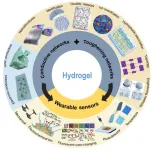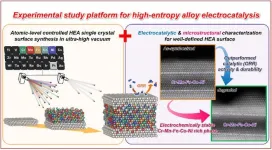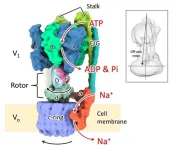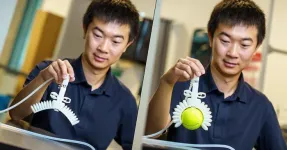(Press-News.org) Scientists have found a way to use nanotechnology to create a 3D ‘scaffold’ to grow cells from the retina –paving the way for potential new ways of treating a common cause of blindness.
Researchers, led by Professor Barbara Pierscionek from Anglia Ruskin University (ARU), have been working on a way to successfully grow retinal pigment epithelial (RPE) cells that stay healthy and viable for up to 150 days. RPE cells sit just outside the neural part of the retina and, when damaged, can cause vision to deteriorate.
It is the first time this technology, called ‘electrospinning’, has been used to create a scaffold on which the RPE cells could grow, and could revolutionise treatment for one of age-related macular degeneration, one of the world’s most common vision complaints.
When the scaffold is treated with a steroid called fluocinolone acetonide, which protects against inflammation, the resilience of the cells appears to increase, promoting growth of eye cells. These findings are important in the future development of ocular tissue for transplantation into the patient’s eye.
Age-related macular degeneration (AMD) is a leading cause of blindness in the developed world and is expected to increase in the coming years due to an ageing population. Recent research predicted that 77 million people in Europe alone will have some form of AMD by 2050.
AMD can be caused by changes in the Bruch’s membrane, which supports the RPE cells, and breakdown of the choriocapillaris, the rich vascular bed that is adjacent to the other side of the Bruch’s membrane.
In Western populations, the most common way sight deteriorates is due to an accumulation of lipid deposits called drusen, and the subsequent degeneration of parts of the RPE, the choriocapillaris and outer retina. In the developing world, AMD tends to be caused by abnormal blood vessel growth in the choroid and their subsequent movement into the RPE cells, leading to haemorrhaging, RPE or retinal detachment and scar formation.
The replacement of the RPE cells is among several promising therapeutic options for effective treatment of sight conditions like AMD, and researchers have been working on efficient ways to transplant these cells into the eye.
Lead author Professor Barbara Pierscionek, Deputy Dean (Research and Innovation) at Anglia Ruskin University (ARU) said: “This research has demonstrated, for the first time, that nanofibre scaffolds treated with the anti-inflammatory substance such as fluocinolone acetonide can enhance the growth, differentiation, and functionality of RPE cells.
“In the past, scientists would grow cells on a flat surface, which is not biologically relevant. Using these new techniques. the cell line has been shown to thrive in the 3D environment provided by the scaffolds.
“This system shows great potential for development as a substitute Bruch’s membrane, providing a synthetic, non-toxic, biostable support for transplantation of the retinal pigment epithelial cells. Pathological changes in this membrane have been identified as a cause of eye diseases such as AMD, making this an exciting breakthrough that could potentially help millions of people worldwide.”
The peer-reviewed, open-access research has been published in the journal Materials & Design and can be read here.
END
Retina cell breakthrough could help treat blindness
Scientists harness nanotechnology to help tackle a common cause of sight loss
2023-07-28
ELSE PRESS RELEASES FROM THIS DATE:
The approaches to achieve high-performance wearable sensors with hydrogels
2023-07-28
This review is written by Dr. Weixing Song from the Department of Chemistry, Capital Normal University. The paper reviewed the toughness and conductive network of existing hydrogel sensors. It emphasized the development status of various hydrogel sensors and highlighted strategies to enhance their mechanical and electrical performance. The findings are valuable for designing components and structures of high-performance wearable hydrogel sensors.
The increasing demand for healthcare IoT devices drives the development of wearable electronics. Electronic skins possess softness, stretchability, and self-healing ...
Enhanced light sensitivity may contribute to Alzheimer's 'sundowning,' disease progression
2023-07-28
New Alzheimer’s research from UVA Health suggests that enhanced light sensitivity may contribute to “sundowning” – the worsening of symptoms late in the day – and spur sleep disruptions thought to contribute to the disease’s progression.
The new insights into the disruptions of the biological clock seen in Alzheimer’s could have important potential both for the development of treatments and for symptom management, the researchers say. For example, caregivers often struggle with the erratic sleep patterns caused by Alzheimer’s ...
Researchers reveal a powerful platform for studying high-entropy alloy electrocatalysis
2023-07-28
Introduced in 2004, high-entropy alloys (HEAs) are alloys composed of multiple principal elements in nearly equiatomic proportions. Their unique chemical composition results in a high degree of chemical disorder, i.e. entropy, and produces remarkable properties such as high strength, ductility, and strong wear-and-tear resistance even at high temperatures. Scientists have dedicated a significant amount of attention to developing novel HEAs to help improve the performance of various electrocatalyst materials.
Because they are made up of differing constituent elements, HEAs' atomic-level surface designs can be complex. But unravelling this complexity is crucial, since the surface ...
San Diego family shares recent tragedy of losing daughter to necrotizing enterocolitis, as NEC Society prepares for the NEC Symposium in San Diego
2023-07-28
San Diego, CA - The NEC Society and Cincinnati Children’s have teamed up to present the NEC Symposium, the only conference in North America dedicated to understanding and preventing necrotizing enterocolitis (NEC). NEC is a devastating intestinal disease that affects medically fragile infants in their first weeks and months of life. Every year in the United States, thousands of babies are diagnosed with NEC and at least one baby dies from NEC every day. The NEC Symposium will transform the NEC Research ...
Citizen science inspires kids to take local action
2023-07-28
North Carolina State University researchers recently found that a program designed to get Girl Scouts involved in citizen science – programs where members of the public can participate in real scientific research – not only taught girls about the process of science, but also motivated them to tackle scientific or environmental problems in their communities.
The findings demonstrate the impacts citizen science projects can have on their participants and offer lessons for other organizations on how to structure STEM-focused learning opportunities using citizen science.
“We’ve found that after participating ...
The structures of six states of a rotary sodium ion pump are revealed
2023-07-28
Six structures exhibited by the rotating sodium ion pump were reconstructed in 3D using cryo-electron microscopy. This analysis revealed that (1) the rotor exhibits non-uniform rotation behavior due to partial structural interference with the stator component, and (2) the rotor interacts with one edge of the large ion transport ring causing it to rotate. The study showed a unique molecular mechanism of the rotary sodium ion pump.
The results will be published on July 28 in Communications Biology.
“In previous single-molecule imaging ...
New research highlights risks of selective adaptation in extreme coral habitats
2023-07-28
Resilient corals, often referred to as ‘super corals’, have recently been seen as potential saviours in the face of climate change and its detrimental effects on coral reefs.
Now, a team of scientists from the University of Technology Sydney (UTS) and the University of Haifa, Israel is working to better understand these corals in order to develop strategies to protect fragile ecosystems such as the Great Barrier Reef.
UTS scientist Dr Emma Camp, co-lead researcher on the study recently published in the journal Nature Communications, says the findings have significant implications ...
What nap times reveal about your child’s brain development
2023-07-28
Infants who nap a lot have smaller vocabularies and poorer cognitive skills – according to new research from the University of East Anglia.
Parents the world over are prone to worry about their children getting either too little or too much sleep.
But a new study published today reveals that some children are more efficient at consolidating information during sleep, so they nap less frequently.
Meanwhile others, usually those with fewer words and poorer cognitive skills, need to nap more frequently.
The research team say that reducing naps for these children will not improve brain development, ...
Activewear angst: Why shopping for workout clothes can be harmful to women
2023-07-28
Though it’s just as likely to be worn while lounging on the couch as in the gym, a large driver of activewear’s popularity among women is its association with a dynamic lifestyle, positive wellbeing and overall good health.
However, two new Edith Cowan University (ECU) studies suggest online shopping for activewear may in fact be harmful to women’s body image.
Sales of “Athleisure” — a hybrid style of athletic clothing typically worn as everyday wear — have risen rapidly following ...
This 3D printed gripper doesn’t need electronics to function
2023-07-28
This soft robotic gripper is not only 3D printed in one print, it also doesn’t need any electronics to work.
The device was developed by a team of roboticists at the University of California San Diego, in collaboration with researchers at the BASF corporation, who detailed their work in a recent issue of Science Robotics.
The researchers wanted to design a soft gripper that would be ready to use right as it comes off the 3D printer, equipped with built in gravity and touch sensors. As a result, the gripper can pick up, hold, and release objects. No such gripper existed before this work.
“We ...
LAST 30 PRESS RELEASES:
Post-stroke injection protects the brain in preclinical study
Cardiovascular risk score predicts multiple eye diseases
Health: estimated one in ten British adults used or interested in GLP-1 medications for weight loss
Exercise to treat depression yields similar results to therapy
Whooping cough vaccination for pregnant women strengthens babies’ immune system
Dramatic decline in new cases of orphanhood in Uganda driven by HIV treatment and prevention programs
Stopping weight loss drugs linked to weight regain and reversal of heart health markers
Higher intake of food preservatives linked to increased cancer risk
Mass General Brigham–developed cholera vaccine completes phase 1 trial
First experimental validation of a “150-year-old chemical common sense” direct visualization of the molecular structural changes in the ultrafast anthracene [4+4] photocycloaddition reaction
Lack of support for people on weight loss drugs leaves them vulnerable to nutritional deficiencies, say experts
Dogs’ dinners can have greater climate impact than owners’
Are you ready to swap salmon for sprats and sardines?
1.6 million UK adults used weight loss drugs in past year
American College of Cardiology comments on new dietary guidelines for Americans
American Society of Gene & Cell Therapy and Orphan Therapeutics Accelerator partner to advance and commercialize promising rare disease treatments
One in 14 patients having day case surgery have new or worse chronic pain 3 months after their operation
New study highlights link between eviction rates and gun violence
Heatwaves heat up soil but not toxin levels in rice, study finds
Digital modeling reveals where construction carbon emissions really come from
Turning farm waste into water filters
New study shows how the spleen helps the immune system accept a transplant
New Mayo Clinic study advances personalized prostate cancer education with an EHR-integrated AI agent
Researchers identify novel therapeutic target to improve recovery after nerve injury
Microbes in breast milk help populate infant gut microbiomes
Reprogramming immunity to rewrite the story of Type 1 diabetes
New tool narrows the search for ideal material structures
Artificial saliva containing sugarcane protein helps protect the teeth of patients with head and neck cancer
Understanding the role of linear ubiquitination in T-tubule biogenesis
Researchers identify urban atmosphere as primary reservoir of microplastics
[Press-News.org] Retina cell breakthrough could help treat blindnessScientists harness nanotechnology to help tackle a common cause of sight loss






